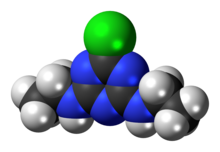Simazine
 | |
 | |
| Names | |
|---|---|
| Preferred IUPAC name 6-Chloro-N2,N4-diethyl-1,3,5-triazine-2,4-diamine | |
| Identifiers | |
CAS Number |
|
3D model (JSmol) |
|
| ChEBI |
|
| ChEMBL |
|
| ChemSpider |
|
| ECHA InfoCard | 100.004.124 |
| KEGG |
|
PubChem CID |
|
| UNII |
|
CompTox Dashboard (EPA) |
|
InChI
| |
| |
| Properties | |
Chemical formula | C7H12ClN5 |
| Molar mass | 201.66 g·mol−1 |
| Appearance | White crystalline powder |
| Density | 1.3 g/cm3 |
| Melting point | 225–227 °C (437–441 °F; 498–500 K) |
Solubility in water | 5 mg/L |
| Solubility in other solvents | Soluble in methanol, chloroform, and diethyl ether; slightly soluble in pentane |
| log P | 1.9600 |
| Vapor pressure | 0.000810 mPa at 20 °C |
Except where otherwise noted, data are given for materials in their standard state (at 25 °C [77 °F], 100 kPa).  N verify (what is N verify (what is  Y Y N ?) N ?) Infobox references | |
Simazine is an herbicide of the triazine class. The compound is used to control broad-leaved weeds and annual grasses.
Preparation
Simazine may be prepared from cyanuric chloride and a concentrated solution of ethyl amine (at least 50 percent by number) in water.[1] The reaction is highly exothermic and is therefore best carried out in an ice bath below 10 °C. It is also essential to carry out the synthesis in a fume hood since cyanuric chloride decomposes at high temperatures into hydrogen chloride and hydrogen cyanide, both of which are highly toxic by inhalation.
Properties and uses
Simazine is an off-white crystalline compound which is sparingly soluble in water. It is a member of the triazine-derivative herbicides, and was widely used as a residual non-selective herbicide, but is now banned in European Union states.[2] Like atrazine, a related triazine herbicide, it acts by inhibiting photosynthesis. It remains active in the soil for two to seven months or longer after application.
See also
References
External links
- Simazine, Extoxnet PIP
- v
- t
- e
- acetochlor
- alachlor
- asulam
- benfluralin
- butachlor
- diethatyl
- diflufenican
- dimethenamid
- flamprop
- metazachlor
- metolachlor
- oryzalin
- pendimethalin
- pretilachlor
- propachlor
- propanil
- trifluralin
- aminopyralid
- chloramben
- clopyralid
- dicamba
- picloram
- pyrithiobac
- quinclorac
- quinmerac
- cacodylic acid
- copper arsenate
- DSMA
- MSMA
- flurochloridone
- isoxaflutole
- leptospermone
- mesotrione
- nitisinone
- sethoxydim
- sulcotrione
- bensulide
- bialaphos
- ethephon
- fosamine
- glufosinate
- glyphosate
- piperophos
| Auxins | |||||
|---|---|---|---|---|---|
| ACCase inhibitors |
|
| Nitrophenyl ethers | |
|---|---|
| Pyrimidinediones | |
| Triazolinones |
|
- dithiopyr
- fluroxypyr
- imazapyr
- thiazopyr
- triclopyr
| Photosystem I inhibitors |
|---|
| Photosystem II inhibitors |
|
|---|
| Photosystem II inhibitors |
|
|---|---|
| ALS inhibitors |











